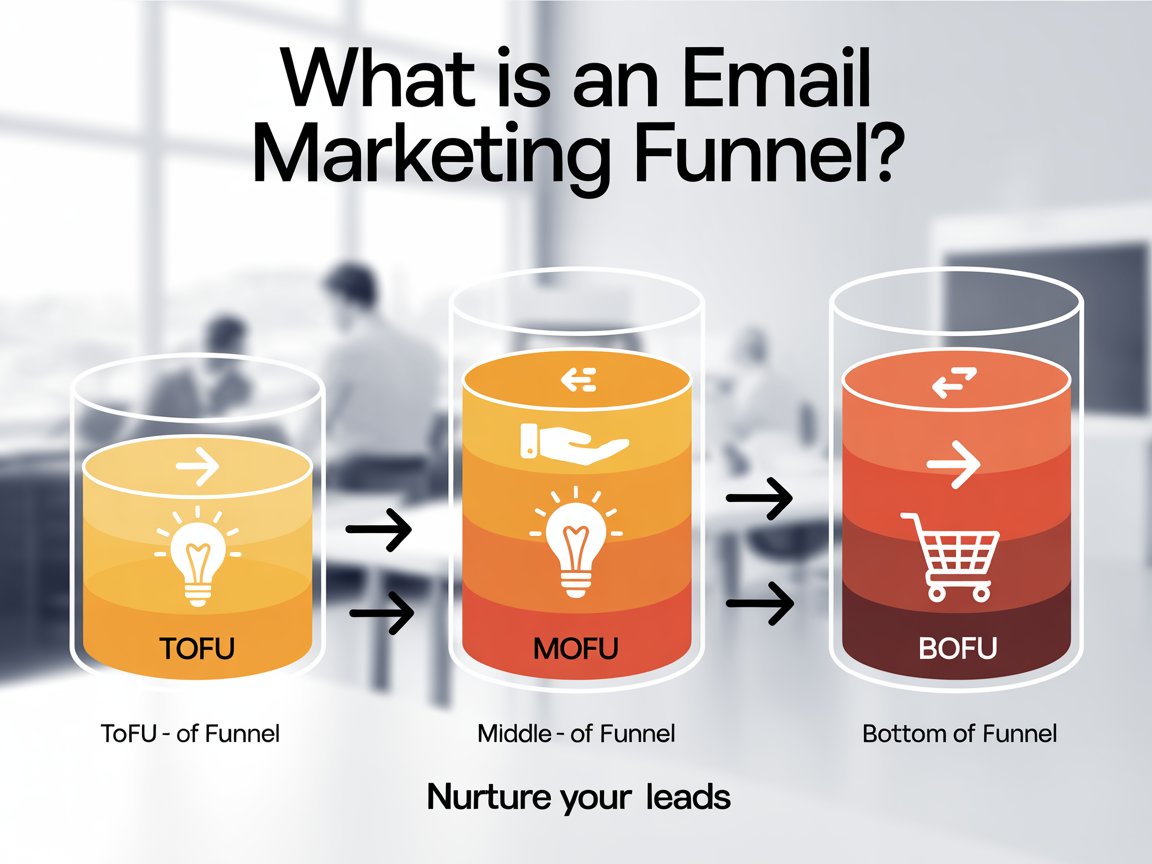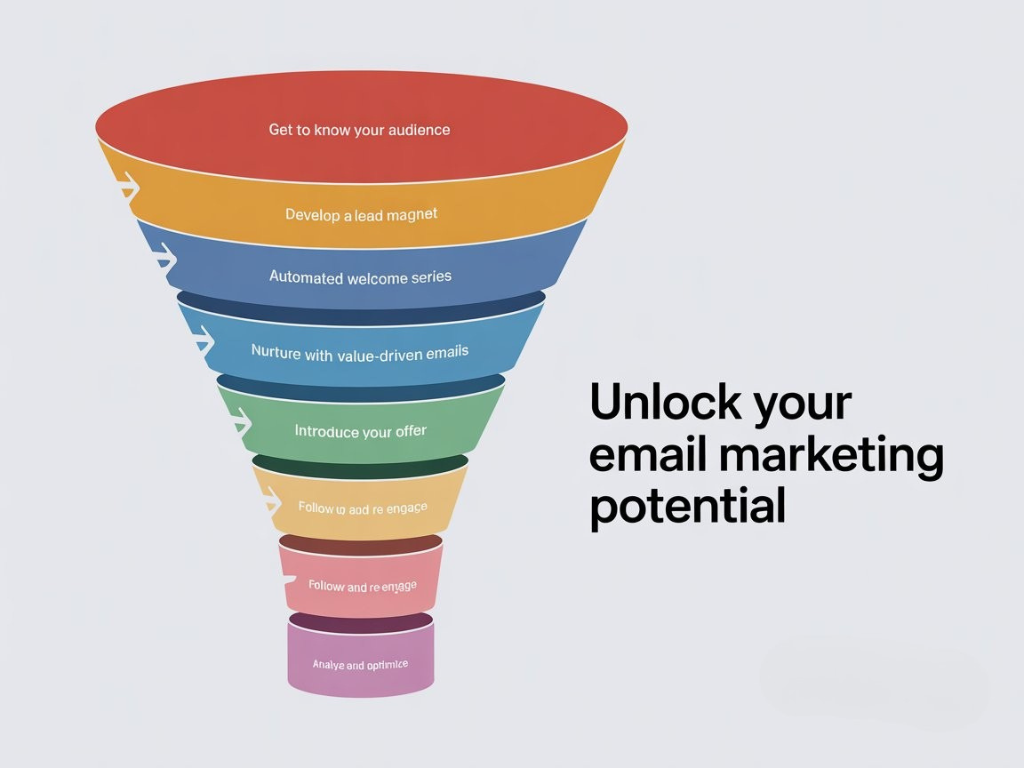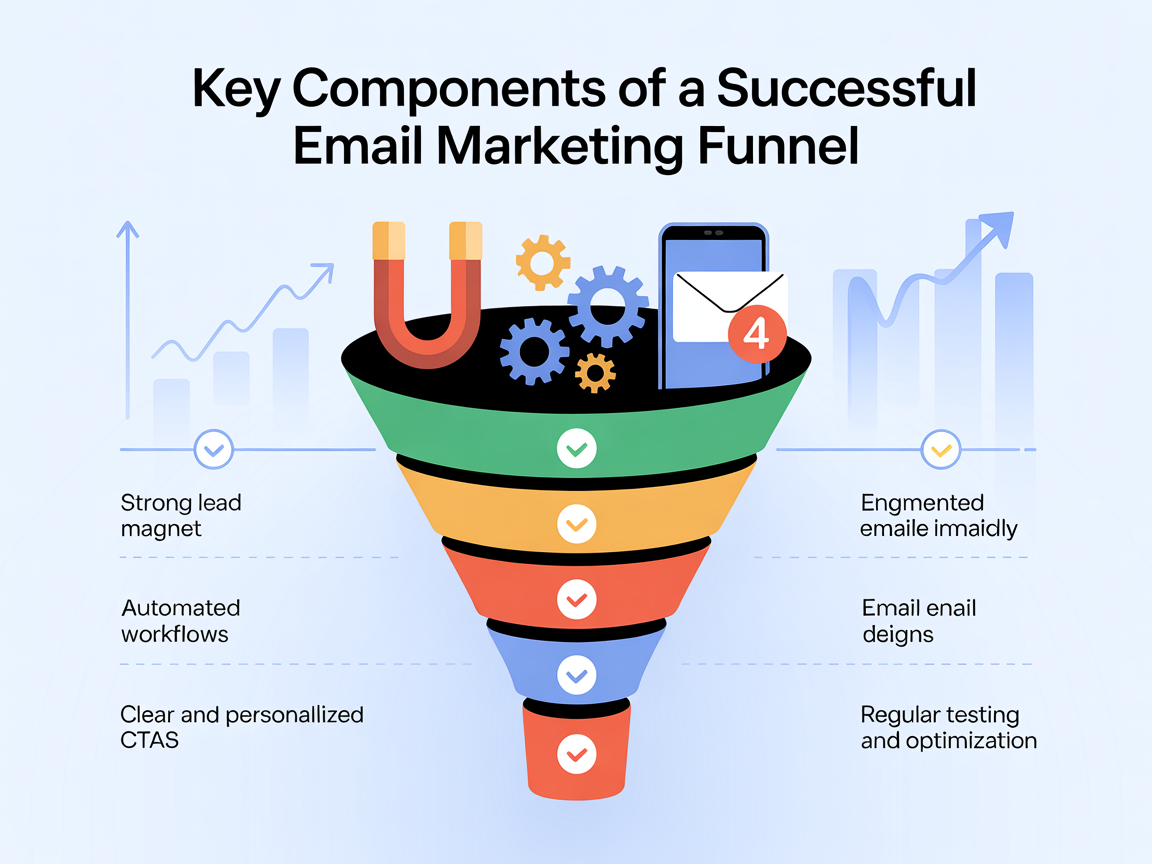Now, just sending random emails in this highly competitive digital world won’t do. You need a process that is really strategic if you want to convert leads into real customers—email marketing funnels fit the bill. We are going to discuss in this blog what an email marketing funnel is, why it is important, and how to build an email marketing funnel that delivers on its promises. Also, if you need a little help to set up your own email funnels, we will hook you up with ConnectMore—your power tool for the marketer and business alike.

What Is an Email Marketing Funnel?
Simply put, an email marketing funnel is a structured series of emails designed to guide a potential customer from first contact to final purchase (and even beyond).
Think of it like a journey:
Top of the funnel (TOFU):
Top of the Funnel” (TOFU) is a marketing phrase representing the start of a customer’s path. In this phase, prospective buyers are starting to recognize a challenge or requirement and are starting to search for knowledge. The core purpose of TOFU marketing is to build recognition and grab a wide group of people.
Key aspects of TOFU:
Audience Goal: Limited; they aren’t ready to purchase.
Objective: Inform, amuse, and build recognition.
Content Approach: Useful and captivating, not pushing sales.
Measurements: Website visits, views, interaction (likes, shares, time spent).
Examples of TOFU Content:
- Blog posts
- Social media content
- Infographics
- Educational videos
- eBooks or guides (ungated or lightly gated)
- SEO-focused content to answer common questions
TOFU Strategy Tips:
- Focus on pain points, not product features.
- Use broad keywords to maximize visibility.
- Optimize for shareability and engagement.
- Capture leads when possible, but prioritize trust and value.
Middle of the funnel (MOFU):
Middle of the Funnel (MOFU) is where prospects have gone beyond awareness, entering the consideration phase. They recognize their issue and are actively seeking solutions – but aren’t prepared to purchase. Your task in this stage is to cultivate, build confidence, and show your value.
Characteristics of MOFU:
Audience Intent: Moderate; they’re evaluating options.
Goal: Educate deeper, build authority, and guide toward a decision.
Content Focus: Solution-oriented, more specific than TOFU.
Metrics: Leads generated, email signups, content downloads, webinar registrations.
Examples of MOFU Content:
- Whitepapers or detailed guides (gated)
- Case studies
- Webinars or live demos
- Product comparison sheets
- FAQs or solution-focused blog posts
- Email nurture campaigns
- ROI calculators or diagnostic tools
MOFU Strategy Tips:
- Focus on how your solution solves their specific problem.
- Use targeted CTAs to move leads toward conversion.
- Provide social proof and use cases.
- Categorize your leads by their actions to deliver tailored content.
Bottom of the Funnel (BOFU):
This stage is the final phase of the marketing funnel, when prospects are ready to purchase. Your goal is to address uncertainties, instill assurance, and drive a conversion. These leads are very qualified and simply require a final nudge.
Characteristics of BOFU:
Audience Intent: High; they’re comparing vendors or solutions.
Goal: Drive conversions (sales, sign-ups, etc.).
Content Focus: Product-centric, proof-driven, and urgency-building.
Metrics: Conversion rate, closed deals, cost-per-acquisition.
Examples of BOFU Content:
- Free trials or product demos
- Sales consultations
- Customer testimonials and video case studies
- Detailed pricing pages
- Competitive comparison guides
- Limited-time offers or discounts
- Success stories with ROI stats
BOFU Strategy Tips:
- Make next steps clear (buy, book, sign up).
- Provide risk-reducers: guarantees, testimonials, free returns.
- Personalize content based on their pain points and interests.
- Align closely with sales teams for handoff and follow-up.
An email marketing funnel helps businesses engage, nurture, and convert leads — all automatically and systematically.
Why Is an Email Marketing Funnel Important?
An email marketing funnel assists in leading prospective customers through the different phases of their buying process—from initially becoming aware to making a purchase—by utilizing relevant and scheduled emails.
Creates Awareness (Top of Funnel)
In the first stage, your emails present your brand and provide valuable content (e.g., blog articles, free materials, or helpful suggestions). This aims to get attention and foster a connection.
Cultivates Leads (Middle of Funnel)
Once people show interest, emails help you educate them about your product or service. You might share case studies, client reviews, or expert advice to gain their confidence and illustrate how you address their needs.
Promotes Conversions (Bottom of Funnel)
At the last stage, emails assist in closing the sale. You might offer discounts, free trial periods, or demonstrations to prompt action. These emails often use personalization and are time-sensitive.
Fosters Loyalty (Post-Purchase)
After a purchase, the funnel carries on. You can use follow-up messages, product instructions, or special deals to keep customers and turn them into regular purchasers.

How to Construct a Successful Email Marketing Funnel
Creating a robust email funnel isn’t just about flooding people with advertisements. It’s about moving them smoothly through each step of their experience. Here’s a process:
1. Get to Know Your Audience
Before writing emails, understand your perfect customer. What do they require, what issues do they face, and what are their objectives? Employ surveys, website data, or brief conversations to build complete customer profiles.
Tip: Divide your audience into groups based on their interests, actions, or demographics for better focus.
2. Develop a Lead Magnet
Provide something valuable at no cost in return for an email address.
Popular lead magnets include:
Ebooks or whitepapers
Free trials or samples
Exclusive webinars
Discount codes
This is your gateway to pulling potential customers into the funnel.
3. Set Up an Automated Welcome Series
First impressions matter! As soon as someone signs up:
Send a friendly welcome email.
Introduce your brand’s story and values.
Set expectations about future emails (like frequency and topics).
A good welcome series builds trust and encourages further engagement.
4. Nurture With Value-Driven Emails
At the middle stage of the funnel:
Provide educational content (how-to guides, case studies, tutorials).
Share success stories and testimonials.
Offer insights that help subscribers solve their problems.
Keep the focus on helping, not selling — the goal is to nurture trust.
5. Introduce Your Offer
Once trust is established:
Send tailored promotional emails.
Highlight the benefits of your product or service.
Use persuasive techniques like scarcity (“limited-time offer”) or social proof (“used by 10,000+ customers”).
6. Follow Up and Re-Engage
Not everyone will buy immediately. Set up:
Reminder emails for abandoned carts.
Re-engagement campaigns for inactive subscribers.
Personalized offers based on previous interactions.
Persistence (without being pushy) pays off!
7. Analyze and Optimize
Finally, track important metrics like:
Open rates
Click-through rates
Conversion rates
Unsubscribe rates
Use these insights to tweak subject lines, content, and offers for better performance.

Key Components of a Successful Email Marketing Funnel
Here’s a quick checklist of must-haves:
✅ Strong lead magnet
✅ Automated workflows
✅ Segmented email lists
✅ Engaging, mobile-friendly email designs
✅ Clear and personalized CTAs (Calls-to-Action)
✅ Regular testing and optimization
How ConnectMore Helps You Build Winning Email Funnels
Creating an effective email marketing funnel sounds like a lot of work — and it can be — unless you have the right tools. That’s where ConnectMore steps in!
With ConnectMore, you can:
Easily design high-converting email campaigns using their intuitive platform.
Automate your email workflows to deliver the right message at the right time.
Segment your audience smartly for ultra-targeted communication.
Analyze campaign performance with powerful, easy-to-read reports.
ConnectMore can be used to simply and expertly create, manage and optimize the email marketing funnels of your new startup or growing business. ConnectMore features are specially designed to engage more with greater conversions and that makes it up-to-date for all businesses that want to go ahead with their email marketing campaign.
Final Thoughts
With an email marketing funnel, you are learning something of value. The icing on the cake comes when this learning leads to improved relationships, the possibility of higher sales, and greater brand loyalty. Real transformation happens when an email marketing program, based on understanding your audience, providing true value, and leading them through each stage carefully, changes from average to spectacular.
If you are serious about doing this right, ConnectMore is your partner. Create more intelligent funnels, boost audience engagement, and elevate your business — all with the strength of a single platform.
Are you ready to revolutionize your email marketing?
Explore ConnectMore!

